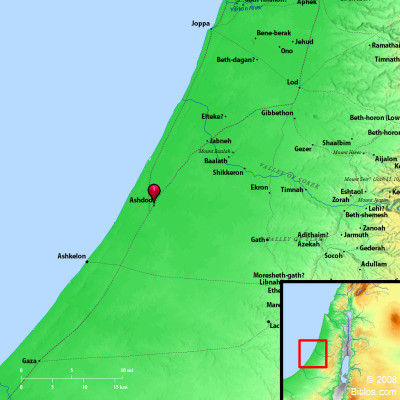Atlas  Azotus (Ashdod) and surrounding region Maps Created using Biblemapper 3.0 Additional data from OpenBible.info You are free to use up to 50 Biblos coprighted maps (small or large) for your website or presentation. Please credit Biblos.com. Occurrences Acts 8:40 But Philip was found at Azotus. Passing through, he preached the Good News to all the cities, until he came to Caesarea.Acts 9:1 But Saul, still breathing threats and slaughter against the disciples of the Lord, went to the high priest, Encyclopedia ASHDODash'-dod ('ashdodh; Azotos; modern Esdud): One of the five chief cities of the Philistines. The name means stronghold or fortress, and its strength may be inferred by the fact that Psammetik I, of Egypt, besieged it for many years (Herodotus says 29). Some of the Anakim were found there in the days of Joshua (Joshua 11:22), and the inhabitants were too strong for the Israelites at that time. It was among the towns assigned to Judah, but was not occupied by her (Joshua 13:3; Joshua 15:46, 47). It was still independent in the days of Samuel, when, after the defeat of the Israelites, the ark was taken to the house of Dagon in Ashdod (1 Samuel 5:1, 2). We have no account of its being occupied even by David, although he defeated the Philistines many times, and we have no definite knowledge of its coming into the hands of Judah until the time of Uzziah (2 Chronicles 26:6). AZO'TUS, see Ashdod. Strong's Greek G108: AztosAzotus (i.e. Ashdod), a Philistine city |



